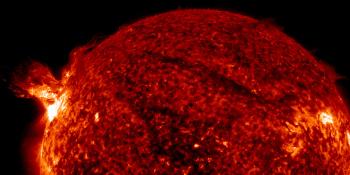Viewing archive of Saturday, 17 August 2002
Solar activity report
Any mentioned solar flare in this report has a scaling factor applied by the Space Weather Prediction Center (SWPC). Because of the SWPC scaling factor, solar flares are reported as 42% smaller than for the science quality data. The scaling factor has been removed from our archived solar flare data to reflect the true physical units.
Report of Solar-Geophysical Activity 2002 Aug 17 2200 UTCPrepared by the NOAA © SWPC and processed by SpaceWeatherLive.com
Joint USAF/NOAA Report of Solar and Geophysical Activity
SDF Number 229 Issued at 2200Z on 17 Aug 2002IA. Analysis of Solar Active Regions and Activity from 16-2100Z to 17-2100Z Solar activity was at moderate levels. Region 69
(S07W03) has produced three M-class events, the largest an M3.4/Sf
at 17/2051 UTC. Other activity from this region has been a number
of C-class events and numerous sub-flares. Region 69 continues to
grow in area and spot count at 1950 millionths and 58 spots, and is
exhibiting multiple magnetic delta configurations within the same
penumbra. Region 79 (S21E18) has shown growth particularly in spot
count. Two new regions were numbered today: Region 82 (N21E06) and
Region 83 (S18E67).
IB. Solar Activity Forecast
Solar activity is expected to be
moderate to high. Region 69 has the potential to produce a major
event.
IIA. Geophysical Activity Summary 16-2100Z to 17-2100Z
The geomagnetic field was at quiet to unsettled condition with one
three-hour period of isolated active levels at 17/0900 UTC. Greater
than 2 MeV electron flux at geosynchronous orbit exceeded event
threshold at 17/1405 UTC, reached a peak value of 1350 pfu at
17/1710 UTC and decreased below threshold levels at 17/1845 UTC.
NASA/ACE data indicates that the solar wind velocities decreased
throughout the day from a peak velocity of 600 km/s to around 450
km/s due to waning coronal hole effects.
IIB. Geophysical Activity Forecast
The geomagnetic field is
expected to be at minor to major storm levels on day one of the
forecast period. A shock arrival from the M5/full halo CME event on
16 August is expected early on day one. The geomagnetic field for
day two and three of the forecast period is expected to be at quiet
to unsettled levels.
III. Event Probabilities 18 Aug to 20 Aug
| Class M | 75% | 75% | 75% |
| Class X | 20% | 20% | 20% |
| Proton | 15% | 15% | 15% |
| PCAF | yellow | ||
IV. Penticton 10.7 cm Flux
Observed 17 Aug 227 Predicted 18 Aug-20 Aug 230/235/235 90 Day Mean 17 Aug 167
V. Geomagnetic A Indices
Observed Afr/Ap 16 Aug 008/017 Estimated Afr/Ap 17 Aug 012/012 Predicted Afr/Ap 18 Aug-20 Aug 050/070-018/020-012/015
VI. Geomagnetic Activity Probabilities 18 Aug to 20 Aug
| A. Middle Latitudes | |||
|---|---|---|---|
| Active | 40% | 30% | 25% |
| Minor storm | 30% | 15% | 10% |
| Major-severe storm | 20% | 05% | 05% |
| B. High Latitudes | |||
|---|---|---|---|
| Active | 40% | 30% | 25% |
| Minor storm | 30% | 15% | 10% |
| Major-severe storm | 20% | 10% | 05% |
All times in UTC
Latest news
Latest forum messages
AR 4299 127AR4299 M8.1 CME 2025/12/06 144AR4294 / 4296 / 4298 419Space Weather Memes 761New paper on the Gannon Storm 10-11 May 2024 2
More topicsSupport SpaceWeatherLive.com!
A lot of people come to SpaceWeatherLive to follow the Solar activity or if there is a chance to see the aurora, but with more traffic comes higher costs to keep the servers online. If you like SpaceWeatherLive and want to support the project you can choose a subscription for an ad-free site or consider a donation. With your help we can keep SpaceWeatherLive online!
Space weather facts
| Last X-flare | 2025/12/08 | X1.1 |
| Last M-flare | 2025/12/08 | M1.2 |
| Last geomagnetic storm | 2025/12/04 | Kp5 (G1) |
| Spotless days | |
|---|---|
| Last spotless day | 2022/06/08 |
| Monthly mean Sunspot Number | |
|---|---|
| November 2025 | 91.8 -22.8 |
| December 2025 | 162.7 +70.9 |
| Last 30 days | 107.4 +11.4 |





